Financial Report: Analysis of Funding Options for Ferry Acquisition
VerifiedAdded on 2020/12/09
|7
|1350
|175
Report
AI Summary
This finance report examines the various sources of funding available to Zylla Limited, a company operating in the transportation sector. The report categorizes these sources into short-term options, such as trade credit, bank overdrafts, and fixed deposits, and long-term options, including share capital, debentures, and bank loans. Each source is evaluated based on its advantages and disadvantages, providing a comprehensive overview to aid in financial decision-making. The report further includes a net present value (NPV) analysis to assess the financial viability of acquiring a new ferry, demonstrating the application of financial principles in a practical scenario. Ultimately, the report concludes by emphasizing the importance of selecting the optimal funding source based on a company's specific requirements and capabilities, considering the inherent trade-offs associated with each option. The report references several academic sources to support its analysis and recommendations.
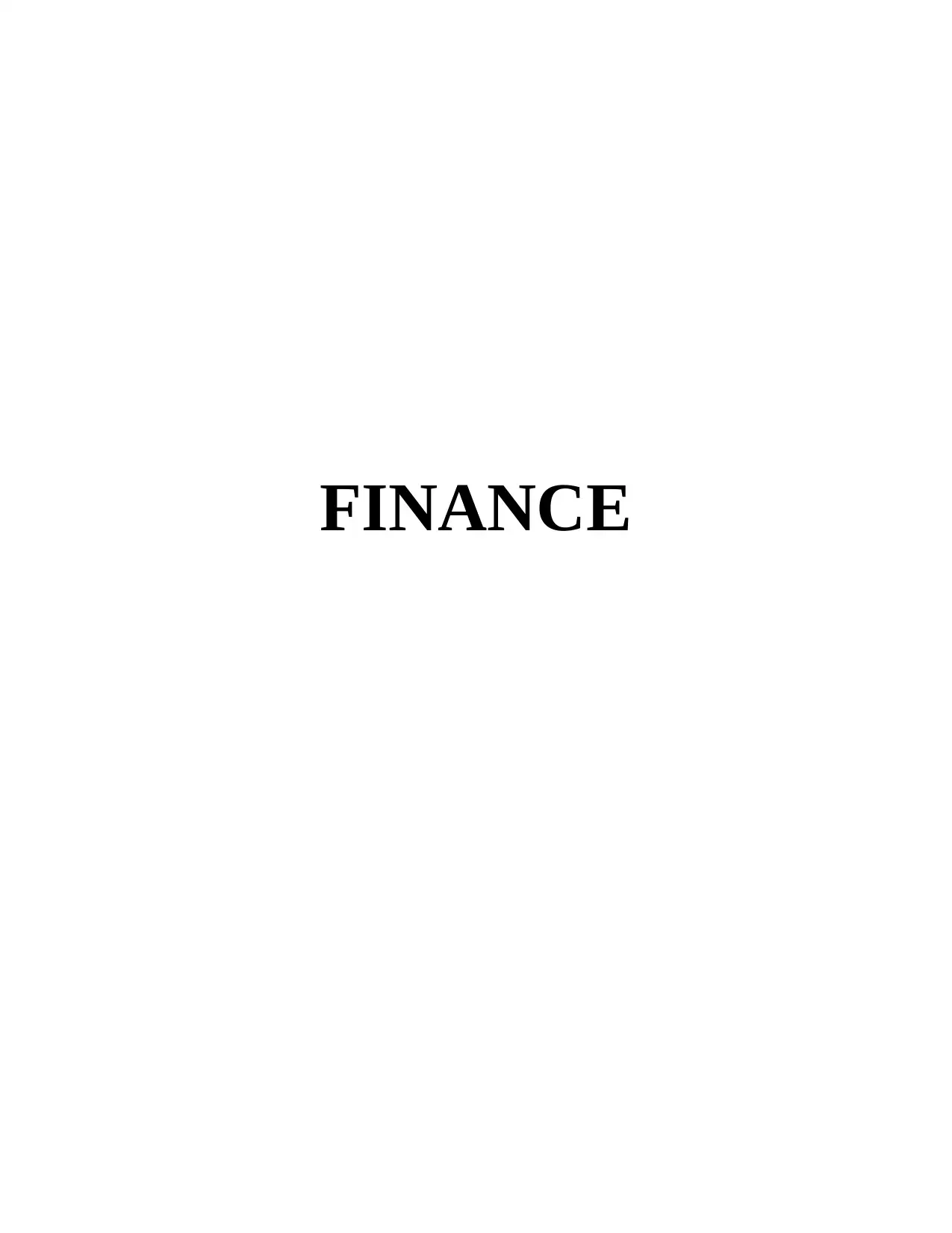
FINANCE
Paraphrase This Document
Need a fresh take? Get an instant paraphrase of this document with our AI Paraphraser

Table of Contents
INTRODUCTION...........................................................................................................................1
MAIN BODY...................................................................................................................................1
CONCLUSION................................................................................................................................4
REFRENCES...................................................................................................................................5
INTRODUCTION...........................................................................................................................1
MAIN BODY...................................................................................................................................1
CONCLUSION................................................................................................................................4
REFRENCES...................................................................................................................................5
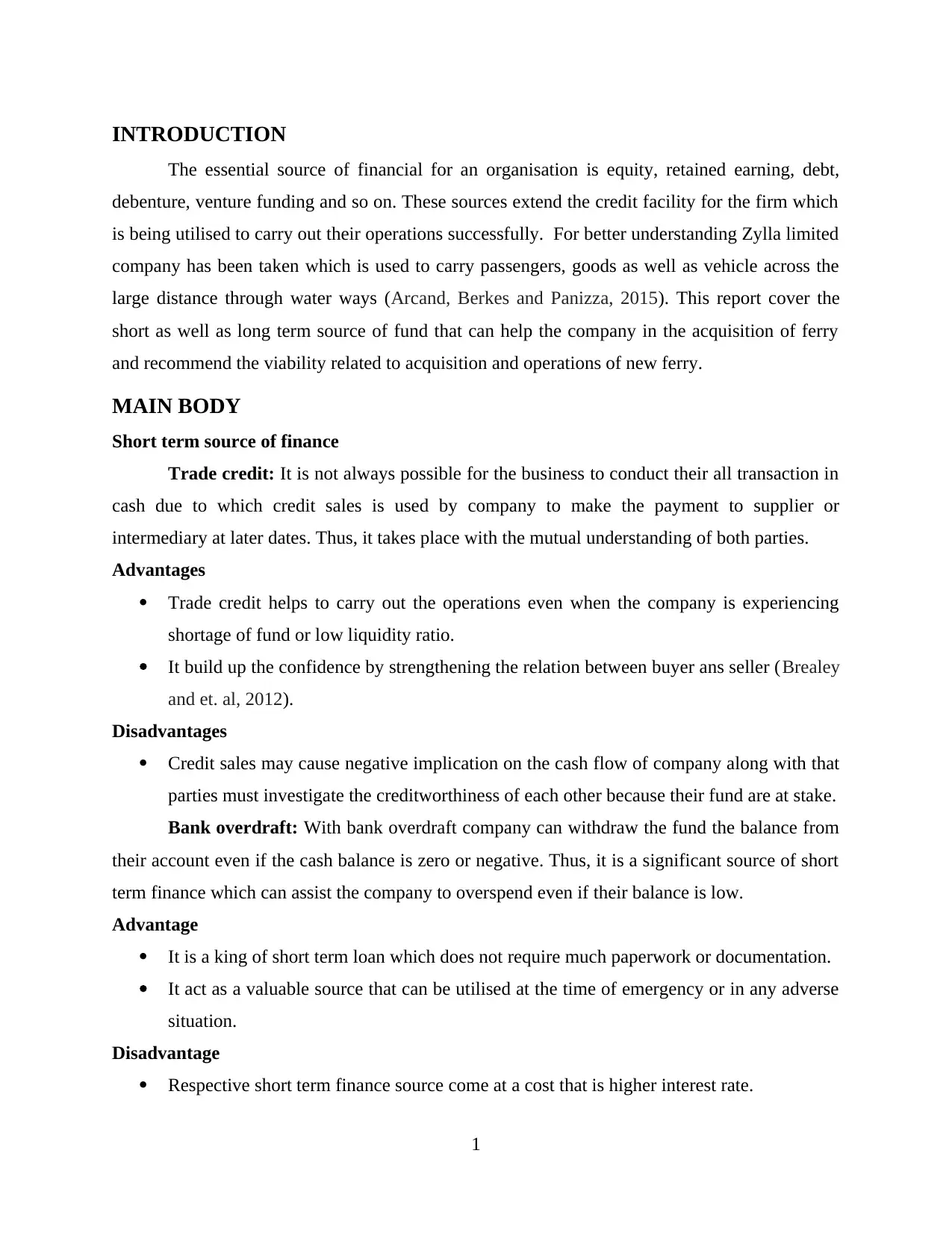
INTRODUCTION
The essential source of financial for an organisation is equity, retained earning, debt,
debenture, venture funding and so on. These sources extend the credit facility for the firm which
is being utilised to carry out their operations successfully. For better understanding Zylla limited
company has been taken which is used to carry passengers, goods as well as vehicle across the
large distance through water ways (Arcand, Berkes and Panizza, 2015). This report cover the
short as well as long term source of fund that can help the company in the acquisition of ferry
and recommend the viability related to acquisition and operations of new ferry.
MAIN BODY
Short term source of finance
Trade credit: It is not always possible for the business to conduct their all transaction in
cash due to which credit sales is used by company to make the payment to supplier or
intermediary at later dates. Thus, it takes place with the mutual understanding of both parties.
Advantages
Trade credit helps to carry out the operations even when the company is experiencing
shortage of fund or low liquidity ratio.
It build up the confidence by strengthening the relation between buyer ans seller (Brealey
and et. al, 2012).
Disadvantages
Credit sales may cause negative implication on the cash flow of company along with that
parties must investigate the creditworthiness of each other because their fund are at stake.
Bank overdraft: With bank overdraft company can withdraw the fund the balance from
their account even if the cash balance is zero or negative. Thus, it is a significant source of short
term finance which can assist the company to overspend even if their balance is low.
Advantage
It is a king of short term loan which does not require much paperwork or documentation.
It act as a valuable source that can be utilised at the time of emergency or in any adverse
situation.
Disadvantage
Respective short term finance source come at a cost that is higher interest rate.
1
The essential source of financial for an organisation is equity, retained earning, debt,
debenture, venture funding and so on. These sources extend the credit facility for the firm which
is being utilised to carry out their operations successfully. For better understanding Zylla limited
company has been taken which is used to carry passengers, goods as well as vehicle across the
large distance through water ways (Arcand, Berkes and Panizza, 2015). This report cover the
short as well as long term source of fund that can help the company in the acquisition of ferry
and recommend the viability related to acquisition and operations of new ferry.
MAIN BODY
Short term source of finance
Trade credit: It is not always possible for the business to conduct their all transaction in
cash due to which credit sales is used by company to make the payment to supplier or
intermediary at later dates. Thus, it takes place with the mutual understanding of both parties.
Advantages
Trade credit helps to carry out the operations even when the company is experiencing
shortage of fund or low liquidity ratio.
It build up the confidence by strengthening the relation between buyer ans seller (Brealey
and et. al, 2012).
Disadvantages
Credit sales may cause negative implication on the cash flow of company along with that
parties must investigate the creditworthiness of each other because their fund are at stake.
Bank overdraft: With bank overdraft company can withdraw the fund the balance from
their account even if the cash balance is zero or negative. Thus, it is a significant source of short
term finance which can assist the company to overspend even if their balance is low.
Advantage
It is a king of short term loan which does not require much paperwork or documentation.
It act as a valuable source that can be utilised at the time of emergency or in any adverse
situation.
Disadvantage
Respective short term finance source come at a cost that is higher interest rate.
1
⊘ This is a preview!⊘
Do you want full access?
Subscribe today to unlock all pages.

Trusted by 1+ million students worldwide
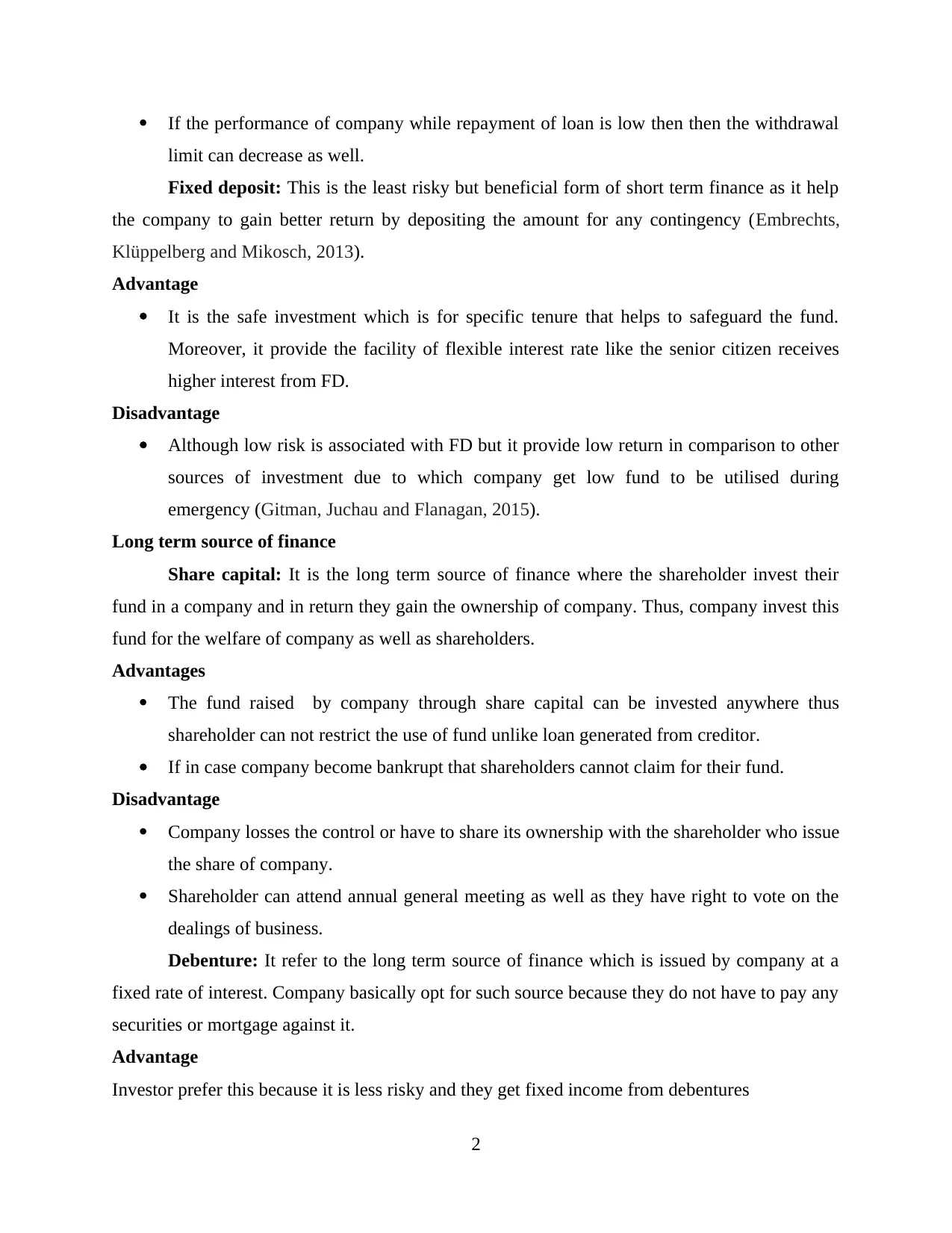
If the performance of company while repayment of loan is low then then the withdrawal
limit can decrease as well.
Fixed deposit: This is the least risky but beneficial form of short term finance as it help
the company to gain better return by depositing the amount for any contingency (Embrechts,
Klüppelberg and Mikosch, 2013).
Advantage
It is the safe investment which is for specific tenure that helps to safeguard the fund.
Moreover, it provide the facility of flexible interest rate like the senior citizen receives
higher interest from FD.
Disadvantage
Although low risk is associated with FD but it provide low return in comparison to other
sources of investment due to which company get low fund to be utilised during
emergency (Gitman, Juchau and Flanagan, 2015).
Long term source of finance
Share capital: It is the long term source of finance where the shareholder invest their
fund in a company and in return they gain the ownership of company. Thus, company invest this
fund for the welfare of company as well as shareholders.
Advantages
The fund raised by company through share capital can be invested anywhere thus
shareholder can not restrict the use of fund unlike loan generated from creditor.
If in case company become bankrupt that shareholders cannot claim for their fund.
Disadvantage
Company losses the control or have to share its ownership with the shareholder who issue
the share of company.
Shareholder can attend annual general meeting as well as they have right to vote on the
dealings of business.
Debenture: It refer to the long term source of finance which is issued by company at a
fixed rate of interest. Company basically opt for such source because they do not have to pay any
securities or mortgage against it.
Advantage
Investor prefer this because it is less risky and they get fixed income from debentures
2
limit can decrease as well.
Fixed deposit: This is the least risky but beneficial form of short term finance as it help
the company to gain better return by depositing the amount for any contingency (Embrechts,
Klüppelberg and Mikosch, 2013).
Advantage
It is the safe investment which is for specific tenure that helps to safeguard the fund.
Moreover, it provide the facility of flexible interest rate like the senior citizen receives
higher interest from FD.
Disadvantage
Although low risk is associated with FD but it provide low return in comparison to other
sources of investment due to which company get low fund to be utilised during
emergency (Gitman, Juchau and Flanagan, 2015).
Long term source of finance
Share capital: It is the long term source of finance where the shareholder invest their
fund in a company and in return they gain the ownership of company. Thus, company invest this
fund for the welfare of company as well as shareholders.
Advantages
The fund raised by company through share capital can be invested anywhere thus
shareholder can not restrict the use of fund unlike loan generated from creditor.
If in case company become bankrupt that shareholders cannot claim for their fund.
Disadvantage
Company losses the control or have to share its ownership with the shareholder who issue
the share of company.
Shareholder can attend annual general meeting as well as they have right to vote on the
dealings of business.
Debenture: It refer to the long term source of finance which is issued by company at a
fixed rate of interest. Company basically opt for such source because they do not have to pay any
securities or mortgage against it.
Advantage
Investor prefer this because it is less risky and they get fixed income from debentures
2
Paraphrase This Document
Need a fresh take? Get an instant paraphrase of this document with our AI Paraphraser
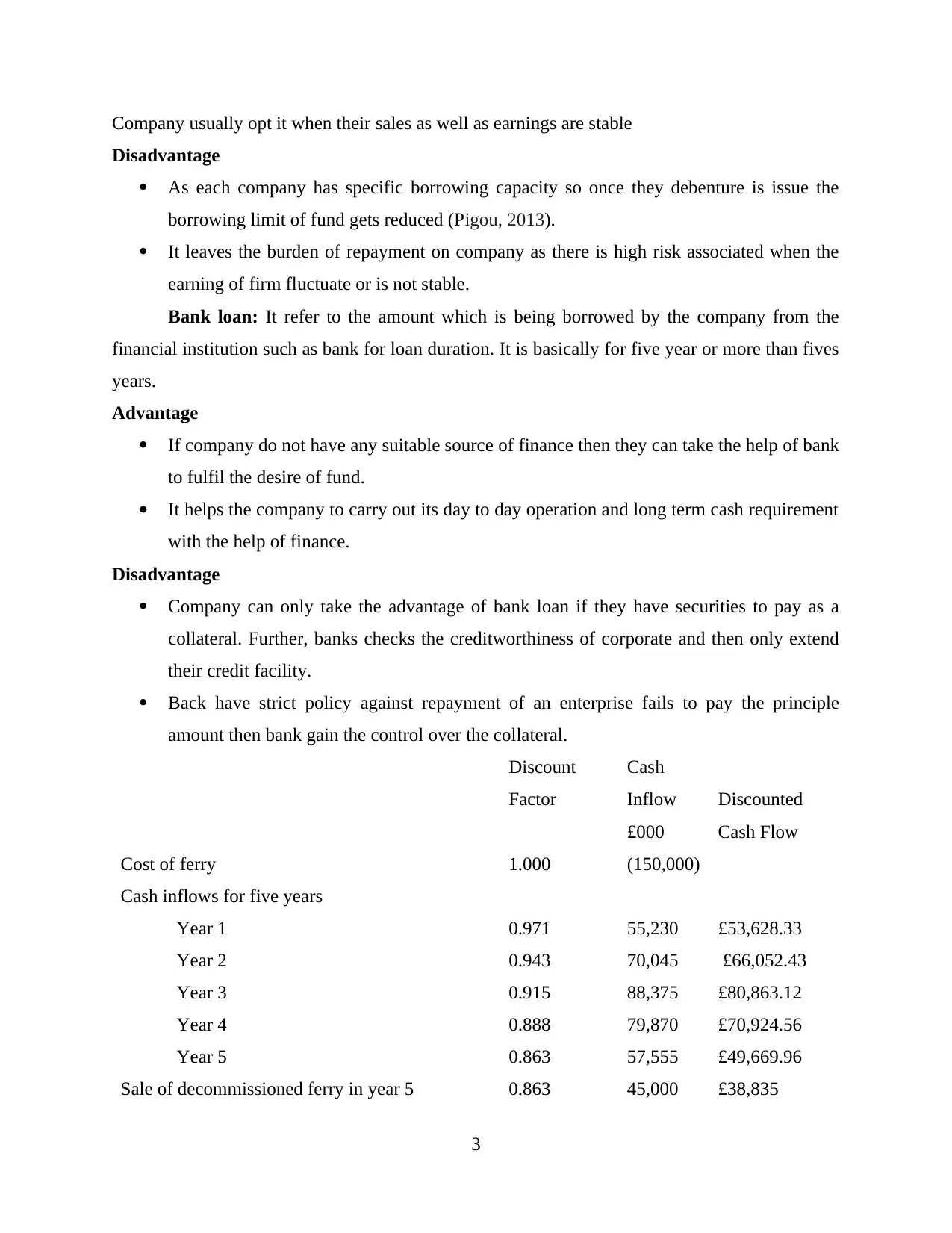
Company usually opt it when their sales as well as earnings are stable
Disadvantage
As each company has specific borrowing capacity so once they debenture is issue the
borrowing limit of fund gets reduced (Pigou, 2013).
It leaves the burden of repayment on company as there is high risk associated when the
earning of firm fluctuate or is not stable.
Bank loan: It refer to the amount which is being borrowed by the company from the
financial institution such as bank for loan duration. It is basically for five year or more than fives
years.
Advantage
If company do not have any suitable source of finance then they can take the help of bank
to fulfil the desire of fund.
It helps the company to carry out its day to day operation and long term cash requirement
with the help of finance.
Disadvantage
Company can only take the advantage of bank loan if they have securities to pay as a
collateral. Further, banks checks the creditworthiness of corporate and then only extend
their credit facility.
Back have strict policy against repayment of an enterprise fails to pay the principle
amount then bank gain the control over the collateral.
Discount
Factor
Cash
Inflow
£000
Discounted
Cash Flow
Cost of ferry 1.000 (150,000)
Cash inflows for five years
Year 1 0.971 55,230 £53,628.33
Year 2 0.943 70,045 £66,052.43
Year 3 0.915 88,375 £80,863.12
Year 4 0.888 79,870 £70,924.56
Year 5 0.863 57,555 £49,669.96
Sale of decommissioned ferry in year 5 0.863 45,000 £38,835
3
Disadvantage
As each company has specific borrowing capacity so once they debenture is issue the
borrowing limit of fund gets reduced (Pigou, 2013).
It leaves the burden of repayment on company as there is high risk associated when the
earning of firm fluctuate or is not stable.
Bank loan: It refer to the amount which is being borrowed by the company from the
financial institution such as bank for loan duration. It is basically for five year or more than fives
years.
Advantage
If company do not have any suitable source of finance then they can take the help of bank
to fulfil the desire of fund.
It helps the company to carry out its day to day operation and long term cash requirement
with the help of finance.
Disadvantage
Company can only take the advantage of bank loan if they have securities to pay as a
collateral. Further, banks checks the creditworthiness of corporate and then only extend
their credit facility.
Back have strict policy against repayment of an enterprise fails to pay the principle
amount then bank gain the control over the collateral.
Discount
Factor
Cash
Inflow
£000
Discounted
Cash Flow
Cost of ferry 1.000 (150,000)
Cash inflows for five years
Year 1 0.971 55,230 £53,628.33
Year 2 0.943 70,045 £66,052.43
Year 3 0.915 88,375 £80,863.12
Year 4 0.888 79,870 £70,924.56
Year 5 0.863 57,555 £49,669.96
Sale of decommissioned ferry in year 5 0.863 45,000 £38,835
3
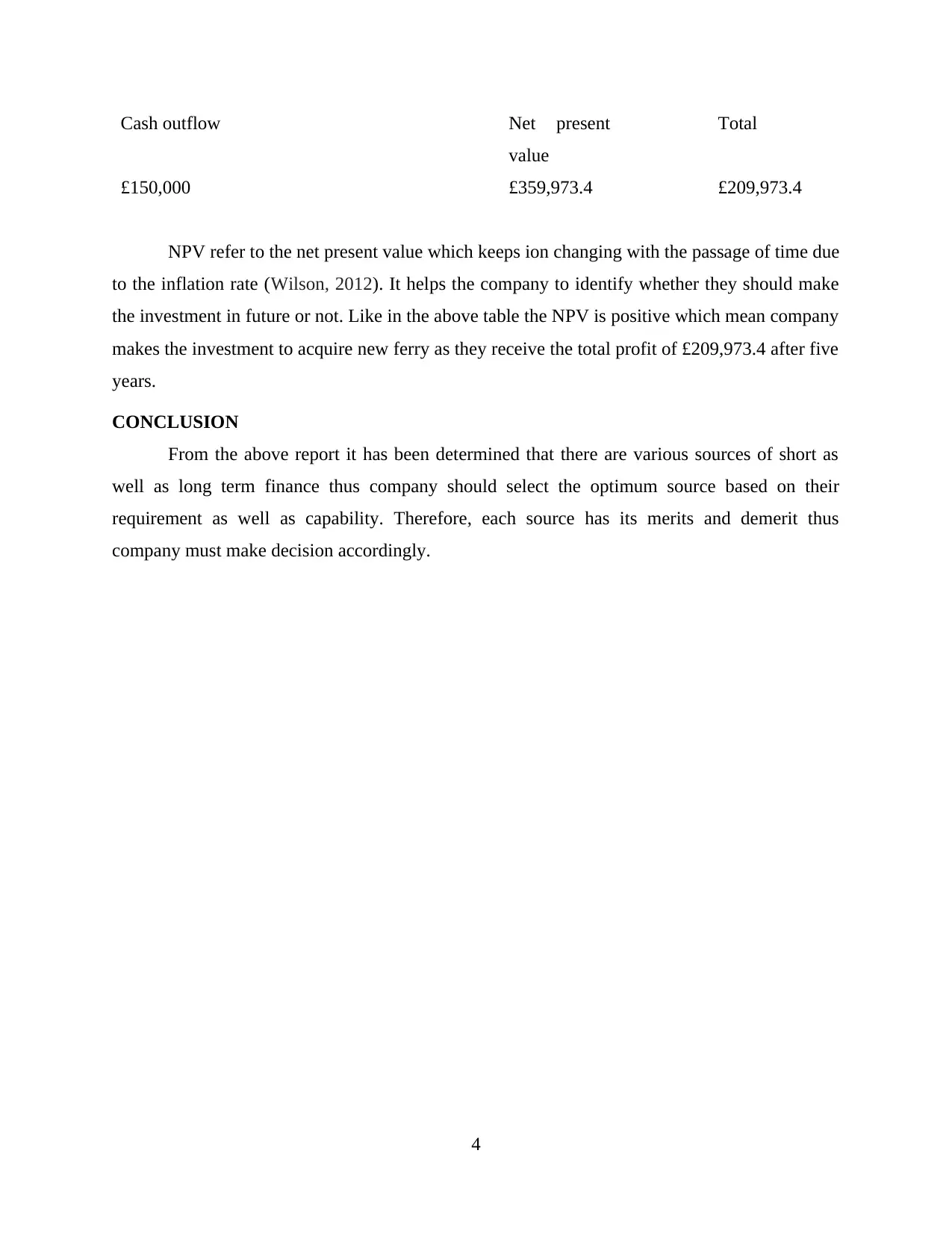
Cash outflow Net present
value
Total
£150,000 £359,973.4 £209,973.4
NPV refer to the net present value which keeps ion changing with the passage of time due
to the inflation rate (Wilson, 2012). It helps the company to identify whether they should make
the investment in future or not. Like in the above table the NPV is positive which mean company
makes the investment to acquire new ferry as they receive the total profit of £209,973.4 after five
years.
CONCLUSION
From the above report it has been determined that there are various sources of short as
well as long term finance thus company should select the optimum source based on their
requirement as well as capability. Therefore, each source has its merits and demerit thus
company must make decision accordingly.
4
value
Total
£150,000 £359,973.4 £209,973.4
NPV refer to the net present value which keeps ion changing with the passage of time due
to the inflation rate (Wilson, 2012). It helps the company to identify whether they should make
the investment in future or not. Like in the above table the NPV is positive which mean company
makes the investment to acquire new ferry as they receive the total profit of £209,973.4 after five
years.
CONCLUSION
From the above report it has been determined that there are various sources of short as
well as long term finance thus company should select the optimum source based on their
requirement as well as capability. Therefore, each source has its merits and demerit thus
company must make decision accordingly.
4
⊘ This is a preview!⊘
Do you want full access?
Subscribe today to unlock all pages.

Trusted by 1+ million students worldwide
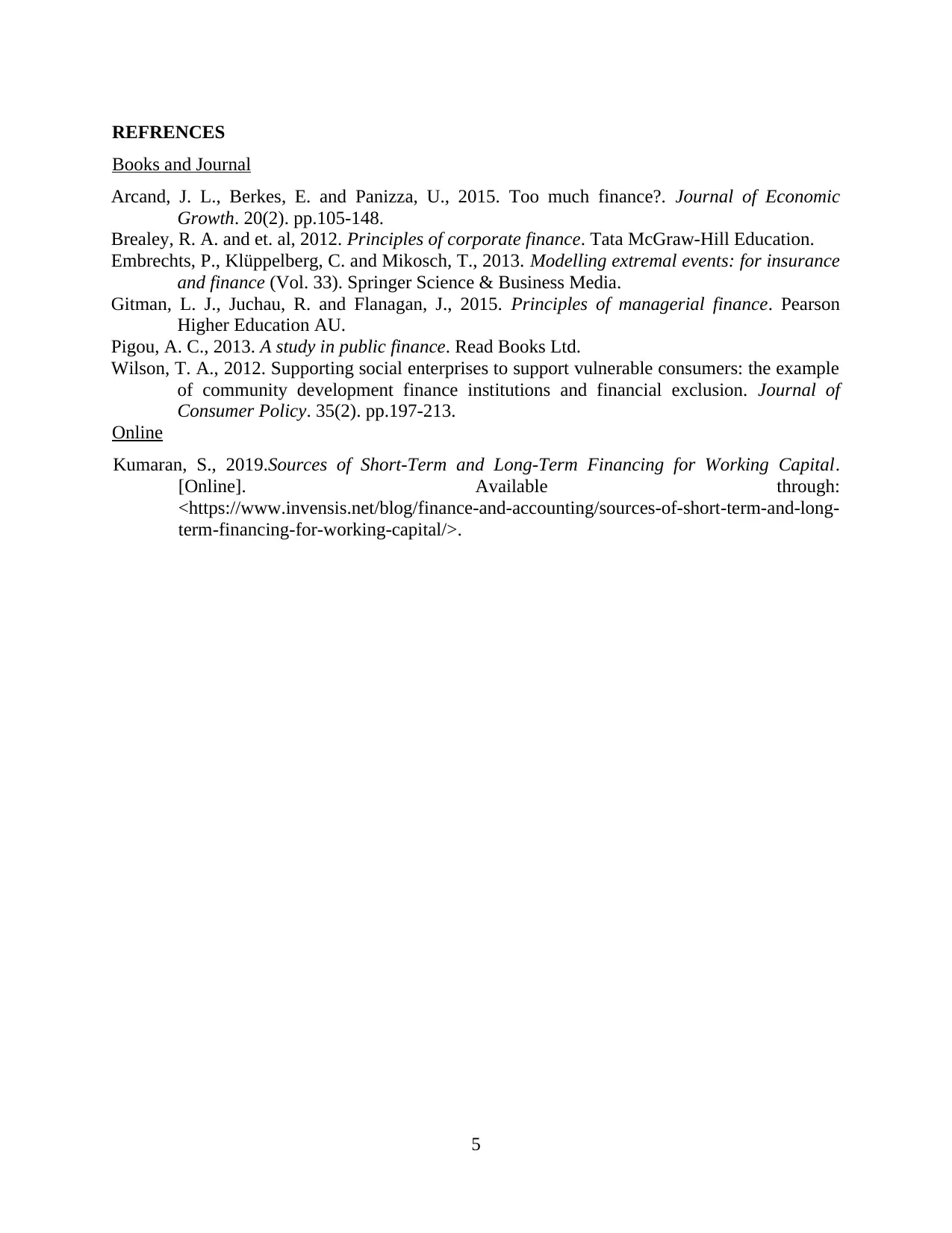
REFRENCES
Books and Journal
Arcand, J. L., Berkes, E. and Panizza, U., 2015. Too much finance?. Journal of Economic
Growth. 20(2). pp.105-148.
Brealey, R. A. and et. al, 2012. Principles of corporate finance. Tata McGraw-Hill Education.
Embrechts, P., Klüppelberg, C. and Mikosch, T., 2013. Modelling extremal events: for insurance
and finance (Vol. 33). Springer Science & Business Media.
Gitman, L. J., Juchau, R. and Flanagan, J., 2015. Principles of managerial finance. Pearson
Higher Education AU.
Pigou, A. C., 2013. A study in public finance. Read Books Ltd.
Wilson, T. A., 2012. Supporting social enterprises to support vulnerable consumers: the example
of community development finance institutions and financial exclusion. Journal of
Consumer Policy. 35(2). pp.197-213.
Online
Kumaran, S., 2019.Sources of Short-Term and Long-Term Financing for Working Capital.
[Online]. Available through:
<https://www.invensis.net/blog/finance-and-accounting/sources-of-short-term-and-long-
term-financing-for-working-capital/>.
5
Books and Journal
Arcand, J. L., Berkes, E. and Panizza, U., 2015. Too much finance?. Journal of Economic
Growth. 20(2). pp.105-148.
Brealey, R. A. and et. al, 2012. Principles of corporate finance. Tata McGraw-Hill Education.
Embrechts, P., Klüppelberg, C. and Mikosch, T., 2013. Modelling extremal events: for insurance
and finance (Vol. 33). Springer Science & Business Media.
Gitman, L. J., Juchau, R. and Flanagan, J., 2015. Principles of managerial finance. Pearson
Higher Education AU.
Pigou, A. C., 2013. A study in public finance. Read Books Ltd.
Wilson, T. A., 2012. Supporting social enterprises to support vulnerable consumers: the example
of community development finance institutions and financial exclusion. Journal of
Consumer Policy. 35(2). pp.197-213.
Online
Kumaran, S., 2019.Sources of Short-Term and Long-Term Financing for Working Capital.
[Online]. Available through:
<https://www.invensis.net/blog/finance-and-accounting/sources-of-short-term-and-long-
term-financing-for-working-capital/>.
5
1 out of 7
Related Documents
Your All-in-One AI-Powered Toolkit for Academic Success.
+13062052269
info@desklib.com
Available 24*7 on WhatsApp / Email
![[object Object]](/_next/static/media/star-bottom.7253800d.svg)
Unlock your academic potential
Copyright © 2020–2025 A2Z Services. All Rights Reserved. Developed and managed by ZUCOL.





